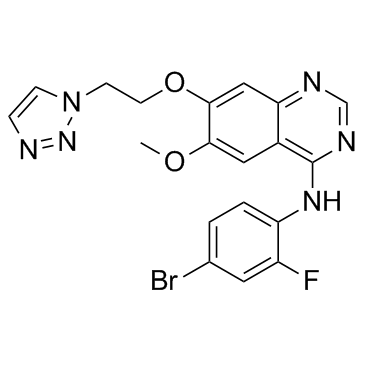413599-62-9
| Name | N-(4-Bromo-2-fluorophenyl)-6-methoxy-7-[2-(1H-1,2,3-triazol-1-yl)ethoxy]-4-quinazolinamine |
|---|---|
| Synonyms |
N-(4-bromo-2-fluorophenyl)-6-methoxy-7-[2-(1H-1,2,3-triazol-1-yl)ethoxy]quinazolin-4-amine
N-(4-Bromo-2-fluorophenyl)-6-methoxy-7-[2-(1H-1,2,3-triazol-1-yl)ethoxy]-4-quinazolinamine 4-Quinazolinamine, N-(4-bromo-2-fluorophenyl)-6-methoxy-7-[2-(1H-1,2,3-triazol-1-yl)ethoxy]- ZD-4190 |
| Description | ZD-4190 is a potent, orally available inhibitor of the vascular endothelial cell growth factor receptor 2 (VEGFR2) and of epidermal growth factor receptor (EGFR) signalling, used for the treatment of cancer. |
|---|---|
| Related Catalog | |
| Target |
EGFR VEGFR2 |
| In Vitro | ZD4190 exhibits cytotoxic activity against the tumor cells[2]. |
| In Vivo | ZD4190 (100 mg/kg, p.o.) effectively delays MDA-MB-435 tumor growth in mice. In ZD4190-treated tumors, 18F-FPPRGD2 uptake has decreased significantly relative to baseline by 26.74±8.12% (p<0.05) on day 1 and by 41.19±6.63% (p<0.01) on day 3, then has returned to baseline on day 7. Tumor uptake of 18F-FLT has also decreased on both day 1 and day 3 after initiation of ZD4190 treatment. However, ZD4190 does not significantly change 18F-FDG uptake in tumors, compared with the control group[1]. ZD4190 (50 mg/kg, p.o.) prevents outgrowth of residual tumour in a muscle model of minimal residual carcinoma[2]. ZD4190 (12.5-100 mg/kg, p.o.) produces a dose-dependent reduction in K(trans) in PC-3 prostate tumors. At 100 mg/kg, ZD4190 reduces K(trans) in PC-3 tumors by 31% following 2 doses and by 53% following 8 doses[3]. |
| Cell Assay | The cytotoxicity of ZD4190 for PDVC57B cells is established when 104 cells are exposed to 1-10 μM ZD4190 for 96 h before MTS solution is added and the optical density measured at 490 nm. Cells are also grown to 40% confluence and treated with 1-100 μM ZD4190 for 7 days and the cytopathic effect examined by staining with crystal violet. |
| Animal Admin | ZD4190 is suspended in a 1% (v/v) solution of polyoxyethylene sorbitan mono-oleate in deionized water and administered by oral gavage (0.1 mL/10 g body weight). In each experiment, mice are randomized to receive either vehicle or ZD4190, administered once daily using a 1 day (at 0 and 22 h) or 7 day (at 0, 24, 48, 72, 96, 120, 144, and 166 h) treatment regimen (i.e., daily administration of compound for 1 or 7 days with an additional dose given 2 h prior to the end of the treatment period) followed by DCEMRI under terminal anesthesia. |
| References |
| Density | 1.6±0.1 g/cm3 |
|---|---|
| Boiling Point | 583.2±60.0 °C at 760 mmHg |
| Molecular Formula | C19H16BrFN6O2 |
| Molecular Weight | 459.272 |
| Flash Point | 306.5±32.9 °C |
| Exact Mass | 458.050201 |
| LogP | 4.16 |
| Vapour Pressure | 0.0±1.6 mmHg at 25°C |
| Index of Refraction | 1.688 |
| Storage condition | 2-8℃ |
